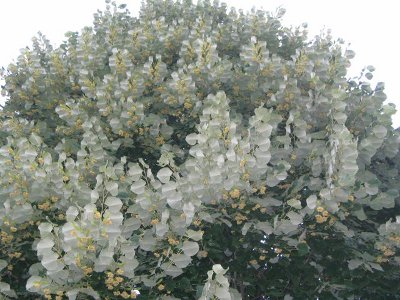Silver Linden Tree
Category: Deciduous Trees

Facts about Silver Linden Tree, "Science name for Silver Linden Tree Tilia tomentosa". The Silver Linden is a tree that belongs to the Malvaceae family, and it is native to the southeastern part of Europe. The Silver Linden Tree is beautiful and stately shade tree which develops an oval symmetrical crown. The name Silver Linden Tree comes from the silvery sheen that is created by tiny hairs that appear on the underside of its leaves.
Silver Linden Tree leaves are made up of many colored pigments, green chlorophyll hides the colors during the growing season of spring and summer. As days get Shorter and cooler temperatures come in the fall, it cause the chlorophyll to break down and than the other color pigments can be seen.
Silver Linden Tree growth is referred to as Meristem (The undifferentiated embryonic plant tissue from which new cells are created, as that at the tip of a root or stem). This tissue can be found at the tips of shoots and leaves. Inside the stem growth in thickness occurs at the vascular cambium.
Silver Linden Trees make their own food from sunlight, carbon dioxide, water, and nutrients from the soil.
Physical description of Silver Linden Tree
The Silver Linden Tree is a deciduous tree that can grow up to 66 to 115 feet (20.11 to 35.05 meters) tall and its trunk can get up to 6 1/2 feet (2 m) in diameter. The Silver Linden Tree has rounded to triangular-ovate leaves that are alternately arranged, the leaves are long about 1 9/16 to 5 /8 inches (4 to 13 cm) and are broad with about 1 3/16 to 1 1/2 inches (3 to 4 cm) petiole, they are green and hairless at the top and with a coarsely toothed marginal edge.
The Silver Linden flowers are pale yellow in color, they have a very strong scent and this helps as they are pollinated by the bees. The tree’s fruit is somewhat dry and nut-like drupe and is 10 mm long and it is slightly ribbed.
Care of Silver Linden Tree
The Silver Linden Tree can easily be grown in an average, medium or slightly dry, well-drained soil. It does pretty well in part of shade to full sun. The Silver Linden Tree does prefer moist yet fertile and well-drained loamy soil but generally adapt to a variety of soil condition. It is considered to be among the best drought resistant of the lindens. The Silver Linden Tree can tolerate the urban conditions. A Full grown Silver Linden Tree can absorb as much as 48 pounds (21.77 kg) of carbon dioxide a year. The same tree could also produce enough oxygen in a day for two people. In a single day, a large Silver Linden Tree can drink up to 100 gallons (378.5 liter) of water from the ground and discharge it into the air.
You can tell a Silver Linden Trees age by the number of growth rings. Growth rings size shows what kind of conditions accrued that year, the temperature and if it was a dry or wet year.
Bark of the Silver Linden Tree protects it from the elements and is made up of dead cells.
Common problems with Silver Linden Tree
There is no serious disease or insect problems related to the Silver Linden Tree. Even though the Verticillium wilt will not occur frequently, it can be very fatal to the tree. Leaf spots, powdery mildew and canker may also occur. Common pests include the scale, the leaf miner, Japanese beetles, borers, aphids and lace bugs. And during the dry seasons the mites can be very troublesome.
Silver Linden Tree roots usually grow two to three times the width of the tree branches. The ideal time to fertilize your Tree is in late fall or early spring. If you want to transplant a tree do it in fall, this is ideal for most trees.

 Back To Category Deciduous Trees
Back To Category Deciduous Trees